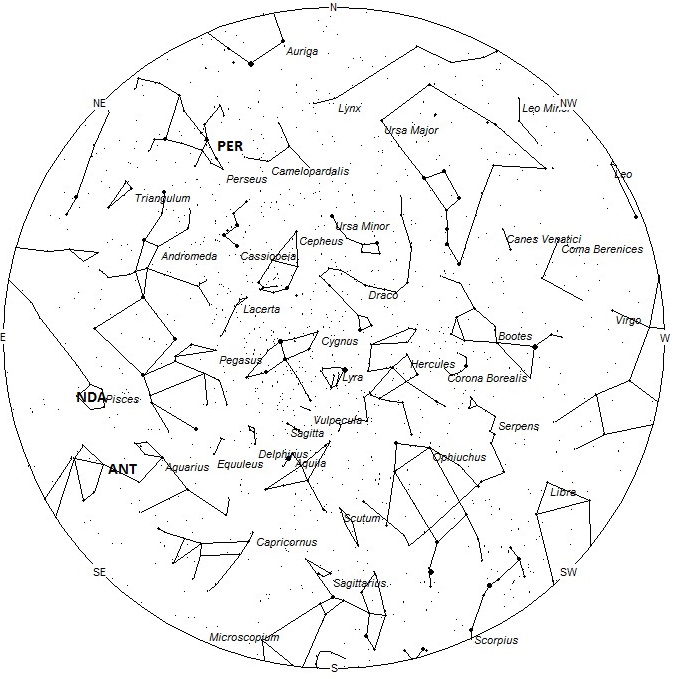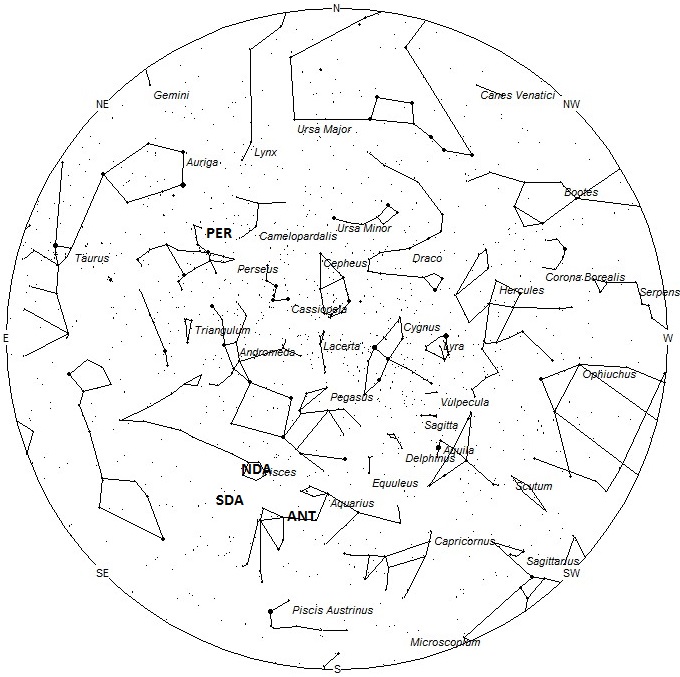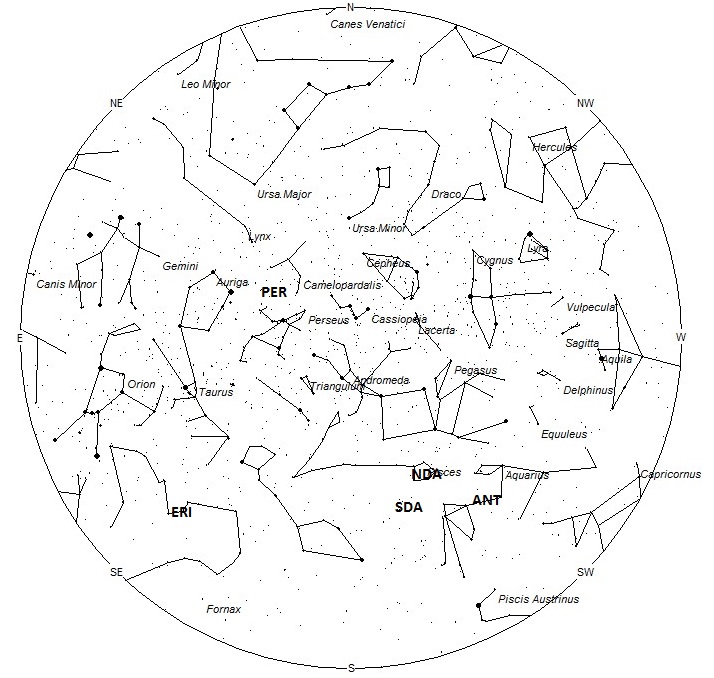During this period the moon will reach its new phase on Monday August 21st. At this time the moon will be located near the sun and will be invisible at night. As the week progresses the waxing crescent moon will enter the evening sky but will not cause any problems for those viewing meteor activity. The estimated total hourly meteor rates for evening observers this week is near 5 for those viewing from the northern hemisphere and 3 for those located south of the equator. For morning observers the estimated total hourly rates should be near 23 as seen from mid-northern latitudes and 13 from the southern tropics. The actual rates will also depend on factors such as personal light and motion perception, local weather conditions, alertness and experience in watching meteor activity. Note that the hourly rates listed below are estimates as viewed from dark sky sites away from urban light sources. Observers viewing from urban areas will see less activity as only the brighter meteors will be visible from such locations.
The radiant (the area of the sky where meteors appear to shoot from) positions and rates listed below are exact for Saturday night/Sunday morning August 19/20. These positions do not change greatly day to day so the listed coordinates may be used during this entire period. Most star atlases (available at science stores and planetariums) will provide maps with grid lines of the celestial coordinates so that you may find out exactly where these positions are located in the sky. A planisphere or computer planetarium program is also useful in showing the sky at any time of night on any date of the year. Activity from each radiant is best seen when it is positioned highest in the sky, either due north or south along the meridian, depending on your latitude. It must be remembered that meteor activity is rarely seen at the radiant position. Rather they shoot outwards from the radiant so it is best to center your field of view so that the radiant lies at the edge and not the center. Viewing there will allow you to easily trace the path of each meteor back to the radiant (if it is a shower member) or in another direction if it is a sporadic. Meteor activity is not seen from radiants that are located far below the horizon. The positions below are listed in a west to east manner in order of right ascension (celestial longitude). The positions listed first are located further west therefore are accessible earlier in the night while those listed further down the list rise later in the night.
These sources of meteoric activity are expected to be active this week.
.
The center of the large Anthelion (ANT) radiant is currently located at 22:40 (340) -07. This position lies in central Aquarius directly between the two 4th magnitude stars known as tau 2 and gamma Aquarii. Due to the large size of this radiant, Anthelion activity may also appear from eastern Capricornus as well as Aquarius. This radiant is best placed near 0200 local summer time (LST), when it lies on the meridian and is located highest in the sky. Hourly rates at this time should be near 2 no matter your location. With an entry velocity of 30 km/sec., the average Anthelion meteor would be of medium-slow velocity.
The Northern delta Aquariids (NDA) are active from July 23 through August 27. The radiant is currently located at 23:32 (353) +05. This position is located in western Pisces, inside the group of faint stars known as the “Circlet”and just 2 degrees southeast of the 4th magnitude star known as theta Piscium. Hourly rates should be near 1 per hour no matter your location. The radiant is best placed near 0300 LST, when it lies highest in the sky. With an entry velocity of 38 km/sec., these meteors would be of medium velocities. This shower seems to be a continuation of the Northern June Aquilids, which had been active since early June.
The Southern Delta Aquariids (SDA) are active from a radiant located at 00:02 (000) -08. This position is located where the borders of Aquarius, Pisces, and Cetus meet. This area of the sky is also 4 degrees northwest of the 4th magnitude star known as Deneb Kaitos Shemali (iota Ceti). Hourly rates are expected to be less than 1 no matter your location. The radiant is best placed near 0400 LST, when it lies highest in the sky. With an entry velocity of 41 km/sec., most activity from this radiant would be of average velocities.
The eta Eridanids (ERI) were discovered by Japanese observers back in 2001. Activity from this stream is seen from July 23 though September 17 with maximum activity occurring on August 11. The radiant currently lies at 03:28 (052) -10, which places it in western Eridanus, 1 degree southwest of the 4th magnitude star known as Ran (epsilon Eridani). This area of the sky is best seen during the last dark hour before dawn when the radiant lies highest in a dark sky. Current rates are expected to be near 1 per hour during this period no matter your location. With an entry velocity of 65 km/sec., the average meteor from this source would be of swift velocity.
The Perseids (PER) are active from a radiant located at 03:52 (058) +59. This position lies in southwestern Camelopardalis, 3 degrees southwest of an unnamed 4th magnitude star. This star lies exactly 10 degrees north of Mirfak (alpha Persei), a 2nd magnitude star and brightest star in the constellation of Perseus. This area of the sky is best placed for viewing during the last dark hour before dawn when it lies highest in the sky. Rates will be around 5 per hour during the morning hours this weekend as seen from the northern hemisphere. Rates seen from the southern hemisphere are expected to be near 1 per hour. With an entry velocity of 59 km/sec., the average meteor from this source would be of swift velocity.
As seen from the mid-northern hemisphere (45N) one would expect to see approximately 14 sporadic meteors per hour during the last hour before dawn as seen from rural observing sites. Evening rates would be near 4 per hour. As seen from the tropical southern latitudes (25S), morning rates would be near 8 per hour as seen from rural observing sites and 2 per hour during the evening hours. Locations between these two extremes would see activity between the listed figures.
The list below offers the information from above in tabular form. Rates and positions are exact for Saturday night/Sunday morning except where noted in the shower descriptions.
.
| SHOWER | DATE OF MAXIMUM ACTIVITY | CELESTIAL POSITION | ENTRY VELOCITY | CULMINATION | HOURLY RATE | CLASS |
| RA (RA in Deg.) DEC | Km/Sec | Local Summer Time | North-South | |||
| Anthelions (ANT) | – | 22:40 (340) -07 | 30 | 02:00 | 2 – 2 | II |
| Northern delta Aquariids (NDA) | Aug 14 | 23:32 (353) +05 | 38 | 03:00 | 1 – 1 | IV |
| Southern delta Aquariids (SDA) | Jul 30 | 00:02 (000) -08 | 41 | 04:00 | <1 – <1 | I |
| eta Eridanids (ERI) | Aug 11 | 03:28 (052) -10 | 65 | 07:00 | 1 – 1 | IV |
| Perseids (PER) | Aug 12 | 03:52 (058) +59 | 59 | 07:00 | 5 – 1 | I |




